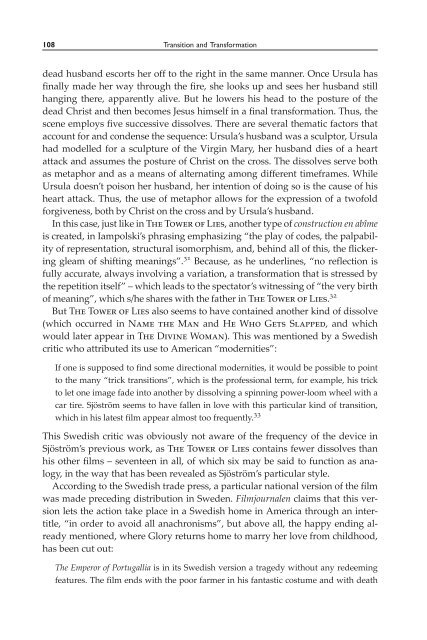FILM FILM - University of Macau Library
FILM FILM - University of Macau Library
FILM FILM - University of Macau Library
You also want an ePaper? Increase the reach of your titles
YUMPU automatically turns print PDFs into web optimized ePapers that Google loves.
108 Transition and Transformation<br />
dead husband escorts her <strong>of</strong>f to the right in the same manner. Once Ursula has<br />
finally made her way through the fire, she looks up and sees her husband still<br />
hanging there, apparently alive. But he lowers his head to the posture <strong>of</strong> the<br />
dead Christ and then becomes Jesus himself in a final transformation. Thus, the<br />
scene employs five successive dissolves. There are several thematic factors that<br />
account for and condense the sequence: Ursula’s husband was a sculptor, Ursula<br />
had modelled for a sculpture <strong>of</strong> the Virgin Mary, her husband dies <strong>of</strong> a heart<br />
attack and assumes the posture <strong>of</strong> Christ on the cross. The dissolves serve both<br />
as metaphor and as a means <strong>of</strong> alternating among different timeframes. While<br />
Ursula doesn’t poison her husband, her intention <strong>of</strong> doing so is the cause <strong>of</strong> his<br />
heart attack. Thus, the use <strong>of</strong> metaphor allows for the expression <strong>of</strong> a tw<strong>of</strong>old<br />
forgiveness, both by Christ on the cross and by Ursula’s husband.<br />
In this case, just like in The Tower <strong>of</strong> Lies, another type <strong>of</strong> construction en abîme<br />
is created, in Iampolski’s phrasing emphasizing “the play <strong>of</strong> codes, the palpability<br />
<strong>of</strong> representation, structural isomorphism, and, behind all <strong>of</strong> this, the flickering<br />
gleam <strong>of</strong> shifting meanings”. 31 Because, as he underlines, “no reflection is<br />
fully accurate, always involving a variation, a transformation that is stressed by<br />
the repetition itself”–which leads to the spectator’s witnessing <strong>of</strong> “the very birth<br />
<strong>of</strong> meaning”, which s/he shares with the father in The Tower <strong>of</strong> Lies. 32<br />
But The Tower <strong>of</strong> Lies also seems to have contained another kind <strong>of</strong> dissolve<br />
(which occurred in Name the Man and He Who Gets Slapped, and which<br />
would later appear in The Divine Woman). This was mentioned by a Swedish<br />
critic who attributed its use to American “modernities”:<br />
If one is supposed to find some directional modernities, it would be possible to point<br />
to the many “trick transitions”, which is the pr<strong>of</strong>essional term, for example, his trick<br />
to let one image fade into another by dissolving a spinning power-loom wheel with a<br />
car tire. Sjöström seems to have fallen in love with this particular kind <strong>of</strong> transition,<br />
which in his latest film appear almost too frequently. 33<br />
This Swedish critic was obviously not aware <strong>of</strong> the frequency <strong>of</strong> the device in<br />
Sjöström’s previous work, as The Tower <strong>of</strong> Lies contains fewer dissolves than<br />
his other films – seventeen in all, <strong>of</strong> which six may be said to function as analogy,<br />
in the way that has been revealed as Sjöström’s particular style.<br />
According to the Swedish trade press, a particular national version <strong>of</strong> the film<br />
was made preceding distribution in Sweden. Filmjournalen claims that this version<br />
lets the action take place in a Swedish home in America through an intertitle,<br />
“in order to avoid all anachronisms”, but above all, the happy ending already<br />
mentioned, where Glory returns home to marry her love from childhood,<br />
has been cut out:<br />
The Emperor <strong>of</strong> Portugallia is in its Swedish version a tragedy without any redeeming<br />
features. The film ends with the poor farmer in his fantastic costume and with death

















